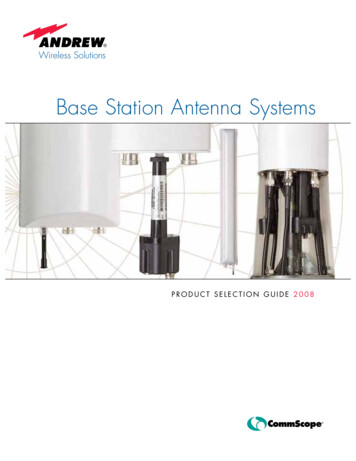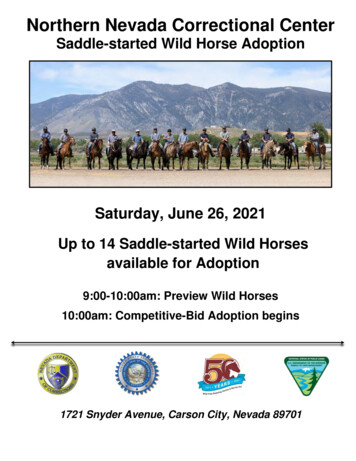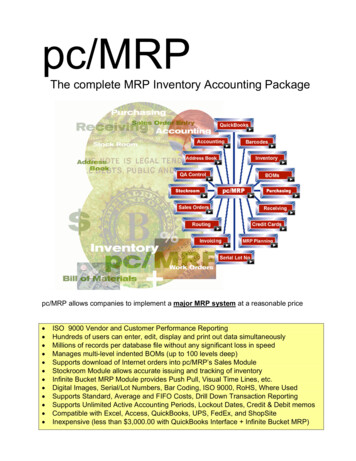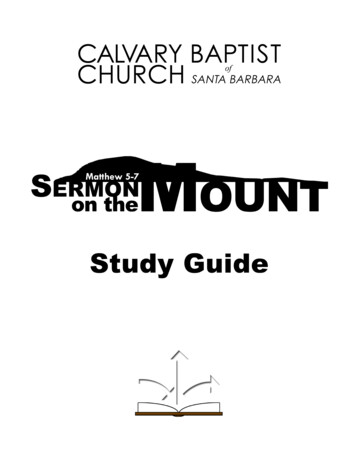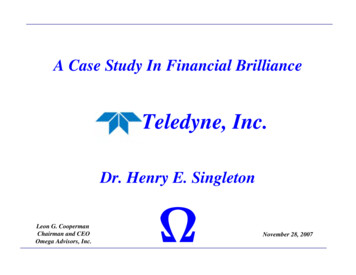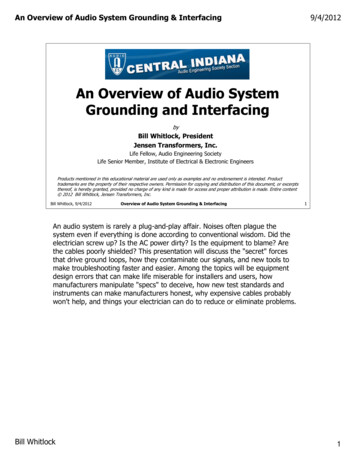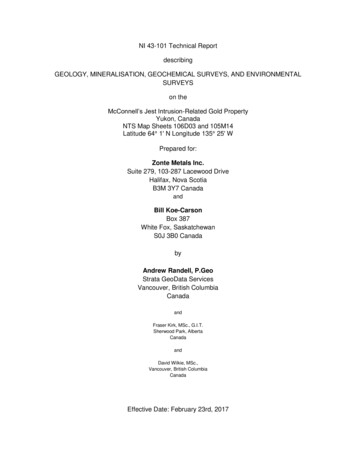
Transcription
NI 43-101 Technical ReportdescribingGEOLOGY, MINERALISATION, GEOCHEMICAL SURVEYS, AND ENVIRONMENTALSURVEYSon theMcConnell’s Jest Intrusion-Related Gold PropertyYukon, CanadaNTS Map Sheets 106D03 and 105M14Latitude 64 1' N Longitude 135 25' WPrepared for:Zonte Metals Inc.Suite 279, 103-287 Lacewood DriveHalifax, Nova ScotiaB3M 3Y7 CanadaandBill Koe-CarsonBox 387White Fox, SaskatchewanS0J 3B0 CanadabyAndrew Randell, P.GeoStrata GeoData ServicesVancouver, British ColumbiaCanadaandFraser Kirk, MSc., G.I.T.Sherwood Park, AlbertaCanadaandDavid Wilkie, MSc.,Vancouver, British ColumbiaCanadaEffective Date: February 23rd, 2017
1.0 Executive SummaryThe McConnells Jest property, located in the central Yukon, lies 65 km northeast of Mayo, Y.T. A seriesof upgrades to the access to the property were conducted during summer 2016, primarily through thecreation of direct road access to the property by the Yukon Government. This road has a number ofculverts and a bridge, the Cristal Creek Bridge, which is rated to carry up to 20 tonnes of load. This roadwould allow the transportation of heavy equipment, including drilling equipment, directly to theproperty. Additionally, during the summer 2016 field season, a number of helicopter landing pads werecleared near areas of geological interest and access points. Helicopter access to the property takesaround 25 minutes from the Mayo airstrip.The McConnell Property consists of 172 contiguous (quartz) claims, owned 100% by Bill Koe-Carson, andcovers an area of approximately 3,371 hectares. On November 17, 2016, Bill Koe-Carson granted ZonteMetals Inc. the option to purchase a 100% interest in the project by making payments of 150,000 overthree years and 1.5 Million common shares over two years. The claims are subject to a 3% NSR, 2/3rdsof which can be purchased for 2,000,000.The property itself has seen limited exploration activity. The property was first staked by United KenoHill Mines in the 1960’s, termed the “Zed” (Z) claims (Minfile number: 106D055). The property wassubsequently staked in 2010 by Bill Koe-Carson. Golden Predator Canada Corp. oversaw soil and rocksampling programs in 2011 and 2012. Bill Koe-Carson conducted rock sampling programs in 2014, 2015and 2016.Mapping took place in 1961 (Green, 1972) by L. Green and the Geological Survey of Canada (GSC) as partof a helicopter-supported party known as the Operation Ogilvie (Minfile# 106D055). Directly south ofthe property, local topographic map sheet 105M was remapped by Roots (1997) of the GSC, and in 2003the GSC released a geological compilation that included this area (Golden Predator Canada Corp., 2013).i
The property underwent glaciation during the McConnell glaciation ( 23,000 years ago; Bond, 1999). Ithas been demonstrated through a number of field seasons that the ground is covered by basal till. Thelack of a distinct soil anomaly is attributed to the presence of loess deposits on the property.The McConnell pluton is one of a series of Cretaceous plutons that have been included in the TintinaGold Province. The Tintina Gold Province (e.g. Hart, 2004) is a belt of Au-deposits in the NorthernCordillera of Yukon and Alaska that are bounded by two dextral transpressional fault systems - theDenali Fault (southern limit) and the Tintina Fault (northern limit). The belt extends beyond the northerntip of the Tintina Fault, into the Selwyn Basin in the Yukon, and into the western-most NWT. Within theTintina Gold Province a series of highly prospective Intrusion-Related Gold (IRGS) deposits form theTombstone Gold Belt, the most significant host to IRGS globally.Paleozoic clastic rocks of the upper Devonian and Mississippian Earn Group underlie the majority of theMcConnell property. These metasedimentary sequences were formed in a submarine fan and channeldeposit setting and subsequently deformed during Cordilleran tectonics. The 7 x 2.5 km McConnellpluton intrudes the Earn Group. The pluton is a mid-Cretaceous Tombstone suite granodiorite intrusionwhich occupies a large portion of the property.Two major mineral properties lie adjacent to McConnells Jest, the Dublin Gulch IRGS deposit to the westand the Keno Hill silver district to the south east. Many similarities exist between McConnells Jest andDublin Gulch (6.3 Moz indicated and inferred, Wardrop Engineering Inc., 2011).A site visit on August 29th 2016 confirmed that the intrusion-related gold system model is the mostappropriate for exploration at McConnell’s Jest. At least 3 distinct igneous phases have been identifiedon the property, confirming that the McConnell’s Jest intrusion is a compositionally zoned pluton.The 2016 field season resulted in the definition of a number of highly prospective zones of the deposit.The most recent target discovered is the Two-Four Zone which lies on the southwestern edge of thepluton. This target is characterized by a high density of auriferous quartz, arsenopyrite and scoroditeveins. Generally the grades in the veins ranged from 4 to 41 g/t Au and were 3-5 cm wide. The PinkMountain target is located in the centre of the pluton. Gold values in the veins are generally less thanii
seen at the Two-Four Zone with a lot of 1 g/t Au and grades up to 7 g/t Au. At the Bullion Zone goldmineralization was identified in scorodite veins in oxidized rock and assaying up to 28.8 g/t Au.An initial environmental assessment of the property was undertaken during the site visit. Thisassessment included an inventory of the plant species observed during an encounter survey at varioussites across the property, and water sampling of water courses to determine the baseline metal contentprior to more advanced exploration activity. No elevated metal content was detected in the watercourses sampled.Several cost-effective strategies to advance the understanding of the property are proposed, includinggeological mapping, a targeted drilling program, and on-going environmental surveys. It is the authorsopinion that the McConnells Jest property exhibits exploration potential for gold and possibly silvermineralisation, and that the evidence gathered thus far is indicative of an intrusion related gold system.iii
Table of Contents1.0 Executive Summary . i2.0 Introduction .13.0 Reliance on Other Experts .14.0 Property Description and Location .24.1 Location .24.2 Claim Information .35.0 Accessibility, Climate, Local Resources, Infrastructure and Physiography .45.1 Accessibility .45.2 Infrastructure .55.3 Physiography .65.4 Climate .86.0 History .97.0 Geology .97.1 Regional Geology .97.2 Property Geology .147.3 Mineralisation .197.4 Statistics .237.4.1 Data Preparation .237.4.2 Correlations.247.4.3 Principal Component Analysis (PCA) .277.5 Surficial Geology .278.0 Deposit Types .289.0 Exploration Programs .3410.0 Drilling .3711.0 Geochemical Analytical Procedure .3711.1 Rocks .3711.1.1 2010 .3711.1.2 2011 .3811.1.3 2012 .3811.1.4 2014 .3911.1.5 2015 .4111.1.6 2016 .4111.2 Water.42iii
12.0 Data Verification .4213.0 Mineral Processing and Metallurgical Testing .4214.0 Mineral Resource Estimates .4215.0 Mineral Reserve Estimates .4216.0 Mining Methods .4317.0 Recovery Methods .4318.0 Project Infrastructure .4319.0 Market Studies and Contracts .4320.0 Environmental Studies, Permitting and Social or Community Impact.4320.1 Social Licence .4420.1.1 First Nations .4420.1.2 Local Populations .4420.1.3 Environmental Issues .4520.1.4 Environmental Assessment .4620.1.5 Water Courses/Basin drainage .4721.0 Capital and Operating Costs .5122.0 Economic Analysis .5123.0 Adjacent Properties .5223.1 Dublin Gulch, Victoria Gold Corp.5223.2 Keno Hill, Alexco Resources Corp. .5324.0 Other Relevant Data and Information .5325.0 Interpretation and Conclusions .5325.1 Geochemical Evidence .5325.1.1 Geochemical Assays .5325.1.2 QEMSCAN .5525.2 Structural Elements .5825.3 Rock Types .6025.4 Interpreted Geology .6326.0 Recommendations .6627.0 References .69iv
List of FiguresFigure 1. Map showing the boundary of the McConnells Jest claim block. Inset shows position within theYukon Territory. . 2Figure 2. Claims numbers of the McConnells Jest . 3Figure 3. Improved infrastructure leading to the property. A: View of the upgraded road leading to theMcConnell’s Jest property. B: Culverts on the road leading to the property. . 4Figure 4. Helicopter landing pad in the Bullion Zone at McConnell’s Jest. 5Figure 5. A view of the McConnell’s Jest Property from the western end on the property facingsoutheast. . 7Figure 6. An aerial view of the Bullion Zone showing the relationship between dead fall and fresh growthvegetation. . 8Figure 7. Map of the Tintina Gold Province for the Yukon Territory and Alaska. Mineral deposits areshown as large circles, mineral occurrences are shown as small circles. Gold deposits in red dots couldbe considered under the same genetic model as McConnells Jest. Deposits marked in black dots are notof the same origin, or are ambiguous in origin. Deposits marked in purple are skarn deposits(predominantly W-bearing). Within the TGP is the Tombstone Gold Belt (TGB; marked in pink) which isthe major host to gold deposits in the Yukon and Alaska. Mair et al. (2006) suggested 450 km of postformation offset along the Tintina Fault, causing displacement of the Fairbanks district. Populationcentres marked are Whitehorse (W), Mayo (Mayo), Dawson (D) and Fairbanks (F). After Hart (2007). . 10Figure 8.Regional geology of the north-western Selwyn Basin showing distribution of plutons,stratigraphic units and structural features. The McConnell pluton is hosted by the DevonianMississippian Earn Group. Modified after Scott Wilson Mining (2010). . 12Figure 9. Stratigraphy of the Selwyn Basin and thrust stacking, modified from Murphy (1997). TheMcConnell pluton was intruded outside of- but proximal ( 10 km) to- the Tombstone Strain Zone. . 13Figure 10. Regional Geology of the McConnells Jest area. A mid-Cretaceous pluton intrudesmetasedimentary rocks . 16Figure 11. Image of the contact between two felsic intrusive phases (Granodiorite A, Quartz Monzonite B) in the Bullion Zone (0477685 E 7099853 N). Smaller images show close--up of each phase. The redline marks the approximate contact between the two felsic intrusive phases . 17Figure 12. Sample of the McConnell’s Jest granodiorite showing aligned biotite grains. Photo from PinkMountain Zone (0478294 E 7099781 N NAD83). . 18Figure 13. Diorite boulder field on north-facing slope of the “Tea Zone” (477491 E 7101350 N). . 19Figure 14. Millimetre scale quartz vein with K-feldspar alteration selvedges in granodiorite. Theselvedges are also oxidised. Photo from Pink Mountain Zone (0478294 E 7099781 N NAD83). . 21Figure 15. Centimetre scale quartz vein in granodiorite. Note the lack of any alteration selvedges. Photofrom Bullion Zone (0477685 E 7099853 N NAD83). . 21Figure 16. Scorodite vein in granodiorite. Inset shows arsenopyrite in the inner portions of the vein alongwith minor quartz. Photo from Top of Pink Mountain Zone (0477687 E 7099851 N NAD83). . 22Figure 17. Scorodite vein swarm with four cm-scale scorodite veins within a c. 15 cm span. Photo fromPink Mountain Zone (0478294 E 7099781 N NAD83). . 22v
Figure 18. Muscovite alteration of the host granodiorite in close proximity to a scorodite vein in theBullion Zone (0477685 E 7099853 N NAD83). . 23Figure 19. Principal Component Analysis (PCA) of select elements at McConnell’s Jest. . 26Figure 20. Schematic model of mineralisation, structures and zonation of an Intrusion-Related GoldSystem. (Hart, 2002). . 33Figure 21. Example of scorodite vein at surface. Sample AA064560 has an assay grade 25g/t Au. . 35Figure 22. Map of administrative boundaries 105M and 106D used to classify the potential flora andfauna on the property. . 46Figure 23. Property drainage and water sampling locations. . 50Figure 24. Lakes and rivers on the McConnell’s Jest property. . 51Figure 25. Claim blocks adjacent to the McConnells Jest property. . 52Figure 26. Map of the McConnells Jest pluton showing the zones of the deposit as defined by 2016prospecting. Pluton is shown in pink, country rocks shown in green. Structural elements are shown inblue and purple dashed lines, soil sampling grid is shown by black dashed lines. . 54Figure 27. Detailed map of mineralisation within the Bullion, Pink Mountain and Two-Four Zones. . 55Figure 28. Stacked histograms showing QEMSCAN analyses for 2016 prospecting at McConnell’s Jest. . 57Figure 29. QEMSCAN image for sample QEM 1/MCJ/2016. Major phases shown are arsenopyrite (green),scorodite (orange) and quartz (pink). . 57Figure 30. Combined aerial photographs for the McConnells Jest property. Flightline A28301 plates 185to 188 were combined to form the image. Scale is 1:30,000. . 59Figure 31. Interpreted structural lineaments on the McConnells Jest property. Three main lineamentsare present, N-S (Purple), SE-NW (Light Blue), SW-NE (Black). Known vein orientations are shown inwhite. . 60Figure 32. Distribution of rock types at McConnells Jest interpreted from field sampling notes andsample photographs. Rock types are overlain on the current YGS map for the area. . 61Figure 33. Rock types and vein orientations on the southern shoulder of the central portion of theMcConnell pluton. 62Figure 34. The proposed revised geologic map of McConnells Jest based on structural interpretation ofthe surrounding geology. . 63Figure 35. Comparison of structural lineaments at Dublin Gulch (left) and McConnells Jest (right). Bothplutons share the same three groups of structural alignments N-S (Purple), SE-NW (Light Blue) and SWNE (Black). The images are drawn to the same scale and show that the exposed surface of the McConnellpluton appears larger than that at Dublin Gulch. . 65List of TablesTable 1. Claim information for the McConnells Jest property. . 3vi
Table 2. Helipad Locations at McConnells Jest . 5Table 3. Pearson and Spearman correlation coefficients for elements at McConnell’s Jest. 25Table 4. Summary of classification evolution for intrusion-related gold systems (Hart, 2005). . 31Table 5. Summary of channel sampling at McConnell’s Jest in 2016. . 36Table 6. Geochemical Analytical Procedures for 2010 to 2016. . 40Table 7. Summary of Plant Species observed. . 48Table 8. QEMSCAN analyses of 2016 prospecting samples at McConnells Jest . 56vii
2.0 IntroductionThe McConnell’s Jest property is in the central Yukon and lies 65 km northeast of Mayo, Y.T. A midCretaceous pluton is the main exploration target for Au and Ag, with a secondary focus on delineatingpotential W-skarns in the contact zones around the McConnells Jest pluton. This report follows a sitevisit by all authors on August 29th 2016, guided by the claim owner, Bill Koe-Carson. All information hasbeen fact checked by Andrew Randell, P.Geo who oversaw the project.This report builds upon the initial summary geological report of Randell et al. (2015) for the property,confirming proposed models and geological associations on the Property, and includes the firstenvironmental sampling on the property. Environmental sampling was conducted to determine thebaseline levels of contaminants and metals in water courses on the property. The report of Randell etal. (2015) was prepared using the Hive crowd consulting model of Strata GeoData Services, and includesall relevant and known exploration data for this site.On November 17, 2016, Bill Koe-Carson granted Zonte Metals Inc. the option to purchase a 100%interest in the project by making payments of 150,000 over three years and 1.5 Million common sharesover two years. The claims are subject to a 3% NSR, 2/3rds of which can be purchased for 2,000,000.3.0 Reliance on Other ExpertsNo other experts were used for this report.1
4.0 Property Description and Location4.1 LocationThe McConnells Jest property is closest to the town of Mayo, which is approximately 100 kilometers tothe southwest. Mayo itself is some 400km from Whitehorse, the Territorial capital, accessed by thepaved and maintained YT-2 N (Alaska Highway N) and YT-11 E highways.The total number of active claims and leases in accordance with the Quartz Mining Act as of 2017 for theMcConnells Jest Property stands at 172 claims, as illustrated in Table 1. At the time of writing, the claimsare 100% held by Bill Koe’-Carson.Figure 1. Map showing the boundary of the McConnells Jest claim block. Inset shows position within the Yukon Territory.2
4.2 Claim InformationTable 1. Claim information for the McConnells Jest property.Claim NameNumber(s)Grant NumberRegistered OwnerMcConnells Jest1 to 40YD16701 to YD16740Bill Koe-Carson - 100%McConnells Jest41 to 52YD54701 to YD54712Bill Koe-Carson - 100%McConnells Jest53 to 56YD54713 to YD54716Bill Koe-Carson - 100%McConnells Jest57 to 120YD54717 to YD54780Bill Koe-Carson - 100%McConnells Jest121 to 125YD61470 to YD61474Bill Koe-Carson - 100%McConnells Jest126 - 172YD126853 - YD126899Bill Koe-Carson - 100%Figure 2. Claims numbers of the McConnells Jest3
5.0 Accessibility, Climate, Local Resources, Infrastructure andPhysiography5.1 AccessibilityThe property is in the central Yukon and lies 65 km northeast of Mayo, Y.T. on map sheet 106D03 and105M14 at 479500 m E and 7100000 m N in NAD83 Zone 8 (Figure 1). The closest sizable town is Mayo,located on the Stewart River, approximately 65 km to the southwest. Mayo is accessible fromWhitehorse via a 460 km all-weather road and is also serviced by the Mayo airport, which is located justto the north of Mayo. Helicopter access to the property takes around 25 minutes from the Mayo airstrip.A series of upgrades to the access to the property were conducted during summer 2016, primarilythrough the creation of direct road access to the property by the Yukon Government (Fig 3.2). This roadhas several culverts and a bridge, the Cristal Creek Bridge, which is rated to carry up to 20 tonnes ofload. This road would allow the transportation of heavy equipment, including drilling equipment,directly to the property. Additionally, during the summer 2016 field season, a number of helicopterlanding pads were cleared near areas of geological interest and access points. The helicopter landingpads are summarised in Table 2. Helipad Locations at McConnells Jest. Figure 4 shows the helicopterlanding pad in the Bullion zone.Figure 3. Improved infrastructure leading to the property. A: View of the upgraded road leading to the McConnell’s Jestproperty.
At the Bullion Zone gold . opinion that the McConnells Jest property exhibits exploration potential for gold and possibly silver mineralisation, and that the evidence gathered thus far is indicative of an intrusion related gold system. . Figure 9. Stratigraphy of the Selwyn Basin and thrust
